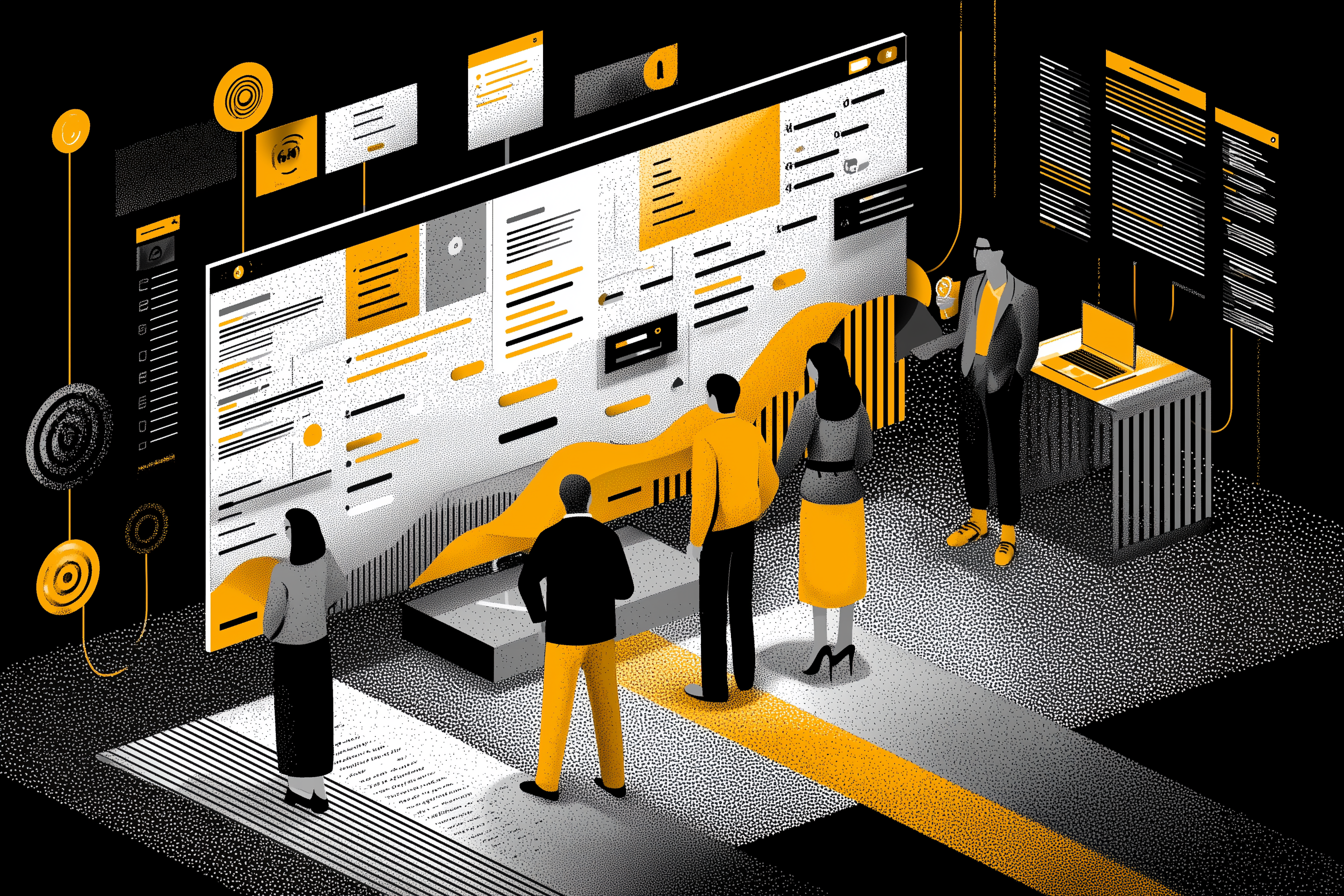The 2026 trends in asset management: generative AI, automation, and hybrid governance

How Generative AI, Automation and Hybrid Governance Are Redefining Creative Asset Management in 2026
Why 2026 Marks a Turning Point for Creative Asset Management
The creative and marketing sector is entering a major transformation phase. The rise of generative AI, the proliferation of automated workflows, and the establishment of hybrid governance models are redefining how brands, agencies and studios manage their assets.
By 2026, brands will no longer simply produce content—they will need to manage their content as true brand assets.
Creative asset management becomes a strategic lever: it connects creation, governance and distribution of content within unified ecosystems.
Collaborative platforms and generative AI are turning this discipline into a pillar of marketing efficiency and brand coherence.
Redefining Asset Management in Creative Teams
From Asset Administration to Value Management
Creative asset management now goes far beyond simply administering files.
It encompasses project planning, team collaboration, version governance, and long-term content valorisation.
Agencies and marketing departments now manage vast libraries of visuals, videos, templates, posts and multilingual reports, produced at an industrial pace.
According to Mordor Intelligence – Content Marketing Market Report 2025–2030, the global content marketing market will reach nearly US$ 990 billion by 2030, growing at an average annual rate of 13.5%.
Where project management stops at delivery, asset management extends value over time.
Every visual, video or campaign becomes a trackable, reusable and measurable asset, integrated into a living library.
This approach transforms creative production into a re-exploitable capital, accelerating creation while reducing content costs.
Generative AI: Catalyst of the New Asset Lifecycle
Generative AI is emerging as the copilot of modern creation.
Its uses are multiplying:
- the generation of visual and textual variants,
- the automatic enrichment of metadata and tags,
- format recommendations according to channels,
- analysis of performance and asset reuse.
According to Deloitte Digital – Marketing Trends 2025, generative AI and automation solutions are now used to increase efficiency, creativity and precision in large-scale content production.
But its greatest impact lies elsewhere: in governance.
AI helps to classify, structure and contextualize content, making intelligent and scalable asset management possible.
“AI does not replace creativity: it guides and multiplies it.” — Forrester Research – The State of Generative AI in Marketing (2024).
Automation and Orchestration: Towards Frictionless Asset Management
The Era of Intelligent Libraries
Brands aim to reduce time and energy lost on searching, duplication or validating assets.
Automation handles tasks such as automatic tagging, visual recognition, compliance alerts, and intelligent versioning.
According to Camphouse – Maximizing Marketing Efficiency: Proven Strategies for 2025, implementing marketing automation tools led to a 12.2% reduction in operational costs and a 14.5% increase in productivity.
More Transparent Processes
These gains are only possible if teams use a shared repository.
Collaborative platforms connect creation tools, ensure asset coherence and document every modification.
In that spirit, MTM promotes fluid governance of creative assets, centralising exchanges and approvals while ensuring version traceability.
This orchestration finally makes visible what was once lost in email chains and scattered approvals.
Hybrid Governance: Balancing Human Oversight and Augmented Intelligence
Governance at Multiple Speeds
Hybrid governance combines a centralised framework (rules, rights, standards) and decentralised execution (team autonomy, AI support).
This model is becoming the standard for global companies that wish to ensure coherence while fostering flexibility.
New Roles Emerge
According to Linedata – Global Creative Operations Survey 2024, 58% of marketing organisations have already appointed “Creative Ops” or “AI Workflow Manager” roles.
Their mission is to ensure fluidity between human production, AI support and quality control.
Asset-Centric Governance and Compliance
Hybrid governance no longer only concerns workflows—it now addresses the assets themselves.
By 2026, brands will structure their reuse policies, rights management and compliance directly at the file level.
AI enables this governance by automating version control, license verification, and enforcing brand standards.
MTM – Collaborative Asset Management Enhanced
Platforms like MTM embody this new approach to creative asset management.
They no longer just track projects—they orchestrate the entire asset lifecycle, from creation to validation, archiving and reuse.
By centralising content and metadata, MTM helps teams build a durable creative heritage, governed, measurable and interoperable.
Key Statistics 2026
The data confirm the acceleration of transformation in creative asset management through AI and automation:
- According to TrueFan – 2026 Marketing Technology Budget Planning Guide, the global marketing AI market will reach US$ 47 billion by 2026, and nearly 88% of marketers will use AI tools daily to plan, create or manage their content and assets.
- From Linedata – Global Creative Operations Survey 2024, 40% of companies have already adopted a hybrid governance approach, combining human oversight, AI and external partnerships to manage their production and validation flows.
- Finally, according to Oracle – Marketing Automation Statistics, automation delivers an average 12.2% reduction in operational costs and a 14.5% increase in productivity, reinforcing the performance of asset-management platforms.
These figures illustrate that by 2026, creative asset management will lie at the heart of brand competitiveness: centralised, AI-augmented and orchestrated by smarter, more transparent collaborative platforms.
Roadmap for Marketing & Creative Teams
- Audit your asset libraries to uncover duplicates, obsolete content and missing metadata.
- Prioritise AI use cases: intelligent tagging, automated approvals, version detection.
- Establish clear governance: rights, access, asset-lifecycle management.
- Train your teams in augmented collaboration and content governance.
- Centralise assets using a collaborative platform that integrates AI, analytics and automation.
Conclusion: Creative Asset Management at the Core of Marketing Performance in 2026
Creative asset management in 2026 will no longer be about simply storing files, it will organise, valorise and animate brand heritage.
Generative AI and automation transform production, but it is hybrid governance that delivers coherence and longevity.
Collaborative platforms like MTM will become structural pillars of creative asset management: they orchestrate the asset lifecycle, streamline creation and guarantee transparency in an ecosystem where speed and quality are inseparable.
The future of brands will not just be about what they create, but how they manage and monetise their assets.
FAQ: Understanding Creative Asset Management in the Age of AI
1. What is creative asset management?
The structured, collaborative management of projects, deliverables and marketing content.
2. How does generative AI transform production?
It automates variant creation, approval and performance analysis.
3. What is hybrid governance?
A model combining AI automation and human oversight to manage creative workflows.
4. Why centralise project and asset management?
To reduce friction, track deliverables and ensure coherence across teams.
5. What benefits can a collaborative asset-management platform bring?
Time savings, visibility, traceability and synergy between creation, production and decision-making.
Sources
- Deloitte Digital – Marketing Trends 2025
- Mordor Intelligence – Content Marketing Market Report 2025–2030
- Linedata – Global Creative Operations Survey 2024
- Camphouse – Maximizing Marketing Efficiency: Proven Strategies for 2025
- Oracle – Marketing Automation Statistics
- TrueFan – 2026 Marketing Technology Budget Planning Guide
Other Posts

How to effectively coordinate multiple teams on a marketing campaign

How to choose the best project management software for your marketing or creative team

